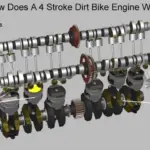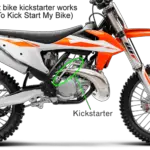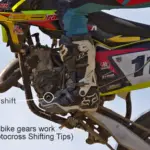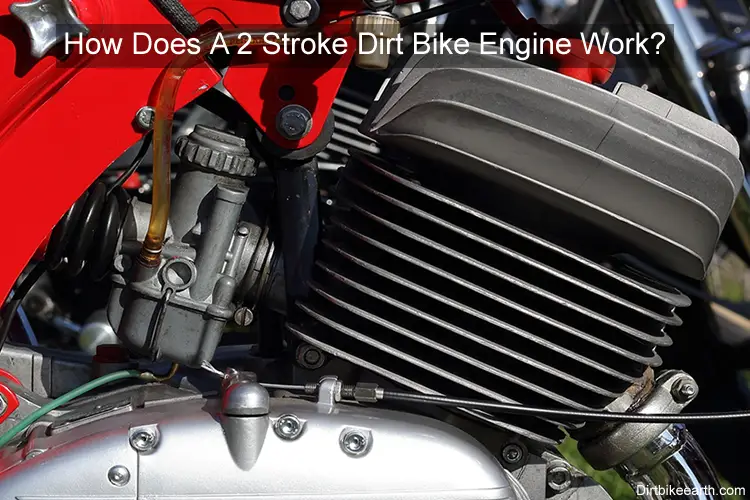
Have you ever wondered how a 2 stroke dirt bike engine works?
The 2-stroke dirt bike engine is simplicity at its best. There are less moving parts and they weigh less than a comparable 4-stroke engine.
How does a 2-stroke dirt bike engine work? 2-stroke dirt bike engines work on two strokes or cycles of a piston. The first stroke draws in an air-fuel mix into the combustion chamber via the transfer port from the crankcase. As the piston nears the top of the cylinder, the spark plug ignites the air-fuel mix which forces the piston down on the second stroke.
How a 2-stroke engine works in more detail
A 2 stroke or two-cycle engine is a type of internal combustion engine. 2-strokes are very much a simpler engine when compared to it’s cousin the 4-stroke engine.
In the past, there were more dirt bikes made with 2 strokes than there were of 4 strokes. But this bias has shifted the other way, as most dirt bikes are currently made with a four stroke engine. I remember thinking 30-plus years ago when the 4 strokes started to come into dirt biking that I’d never buy a 4 stroke. 2 strokes were much more poky and had much better acceleration than the 4 strokes back then.
This is still the case of a two stroke engine. A two stroke engine can produce up to twice the amount of power than a four stroke engine of the same cylinder capacity. This is because it fires once every revolution, whereas the four stroke fires once every other revolution. For example, a two stroke 125 dirt bike would have similar power to a 250 four stroke dirt bike.
The reason why 2 strokes were used before was because of their simplicity and light weight construction. However, 2 stroke engines are not as emission friendly and produce more hydrocarbon emissions because of the wasted fuel escaping via the exhaust.
The way a 2-stroke engine works is that it completes a power cycle in only one crankshaft revolution and with two strokes of the piston. The ‘two strokes’ is represented by one up movement and one down movement of the piston (see animated video below).
How the 2 stroke process works
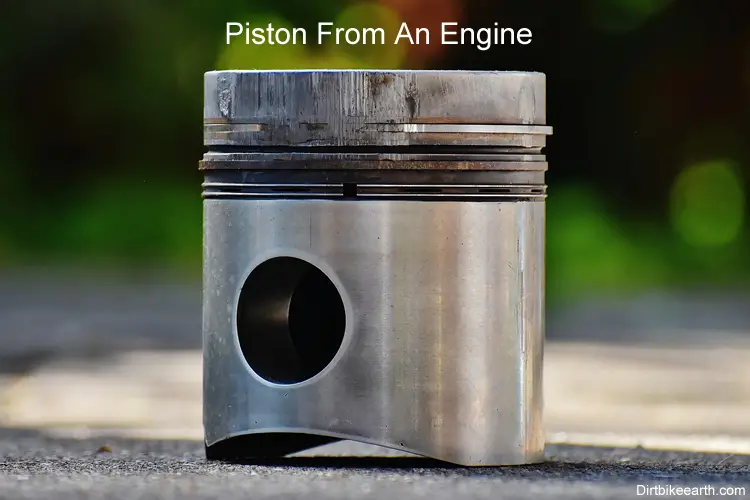
Before I explain the two cycles of a two stroke engine, I want to cover the ports on the engine, as follows:
There are usually three ports on a 2 stroke engine, as follows:
- Inlet port – this introduces the fuel air mixture into the crankshaft chamber (or crankcase). The fuel on a 2 stroke is mixed with 2-stroke oil, which is how a 2 stroke engine is lubricated. This is either fed by a carburetor using a fuel-oil pre-mix or via a fuel injection system, where the oil is pumped directly into the fuel port from an oil reservoir. This inlet port usually has what’s known as a reed valve. The reed valve is designed to ensure the air-fuel mix only flows in one direction.
- Transfer port – The transfer port leads from the crankshaft chamber to the cylinder head. This is where the air-fuel mix is transferred to the combustion chamber ready for combustion. On the downward stroke of the piston, this air fuel mix is compressed, which is what forces the mixture into the cylinder via the transfer port.
- Exhaust port – This is the port that leads to the exhaust system. This is where the burnt fuel and exhaust fumes are expelled from the cylinder. The downside of a 2 stroke engine is that both the transfer port and the exhaust ports are open at the same time. This results in a certain amount of un-burnt fuel escaping via the exhaust port.
The two-stroke cycle of a 2 stroke engine and how it works
On a 2 stroke engine, the engine combusts on every cycle of the piston. The first stroke of the engine starts with the piston roughly half way up the cylinder. The piston is on its upwards stroke at this stage in the cycle. The upwards motion of the piston causes a reduced pressure in the chamber below the piston, which is the crankshaft chamber (or crankcase).
As the piston moves up, the inlet port is uncovered. The reduced pressure draws in an air-fuel mix into the crankshaft chamber via the inlet port.
As the piston reaches the top of its stroke, the air-fuel mix is compressed and then the spark plus ignites this mixture. When the piston is at the top of its stroke, this is known as Top Dead Centre or TDC. The high pressure of the burning gasses forces the piston down. This is the second stroke of the 2 stroke engine.
I remember spending many an hour fixing my motorbikes and having to align the timing of the spark with TDC. Aligning the timing of the spark from the spark plug to be at TDC is crucial. If the plug sparked either two early or too late the engine would either not run or it would run, but inefficiently and with less power.
The downward stroke of the piston
The inlet port is covered by the piston on it’s way down, which stops any more fuel from being sucked into the lower chamber. But the piston continues in the downward stroke until both the transfer port and the exhaust ports are fully exposed. When the piston is right at the bottom of the stroke, this is known as Bottom Dead Centre or BDC.
The fuel-air mix that was drawn into the crankshaft chamber on the first stroke, when the piston rose up in the cylinder, is now forced into the combustion chamber. The combustion chamber is the gap left at the top of the cylinder between the top of the piston and the cylinder head. This is the capacity that gives an engine it’s ‘power-name,’ for example a 250cc. This gap left in the cylinder with the piston at BDC is the volume or CC of the engine.
At the same time the exhaust fumes from the burnt gases are released out of the exhaust port. These gases are transported along the exhaust system.
The two-cycle process then begins once more.
The crankcase of a four stroke as a comparison to a two stroke engine
For comparison, the crankcase on a 4-stroke engine is full of lubricating engine oil. So the fuel on a four stroke engine doesn’t enter the combustion chamber via the crankcase. Instead the fuel is fed directly into the combustion chamber via openings at in the cylinder head.
The 2 stroke engine gets its lubrication from the oil mixed in with the fuel. So as the air-fuel mix enters the crankcase, which is ladened with oil, a certain percentage of the oil mixed in with the fuel remains on the moving parts and lubricates.
If you forget to add oil to the fuel on a 2 stroke engine, it will seize.
Animated video of a 2 stroke engine
I have included an animated video of a 2 stroke engine and how it works below. Apologies for the voice over of this video. Whilst the voice is a bit strange, the video and explanation is excellent.
The components of a 2-stroke engine
There are between 30-50% less moving parts on a 2-stroke compared to a 4-stroke. The components of a two stroke include the following:
- Piston – which forms the basis of the combustion engine.
- A cylinder block and head – which is what houses the piston(s).
- Fuel inlets – This is a non-valved opening, unlike the 4-stroke engine.
- Exhaust outlet – This is a non-valved opening, unlike the 4-stroke engine.
- Crankshaft – Connects to the piston shaft and drives the power via the clutch through to the gearbox and then to the rear wheel.
Lighter weight 2-stroke is an advantage for dirt biking
A 2-stroke engine has less moving parts compared to a 4-stroke, which results in a lighter weight engine. The lightweight advantage of the two stroke was a great advantage to dirt bike racing. The pros got twice the power from the engine, as they would from a 4 stroke, but a a fraction of the weight.
But as already explained, the traditional two stroke engine is less friendly to the environment. Plus they are extremely noisy too, when compared to the four stroke engine dirt bikes.
I hope you enjoyed this article about how does a 2 stroke dirt bike engine work
I’d love to hear from you. Tell us about your adventures of dirt biking in the comments below. Please also share your photos. Either from your cameras or videos from your Gopro’s!
If this article hasn’t answered all of your questions. If you have more questions about dirt biking (or specifically about how does a 2 stroke dirt bike engine work), please comment below with your questions.
There will also be many more articles about dirt biking for you to read and learn about this fabulous sport and hobby.
Have fun and be safe!
